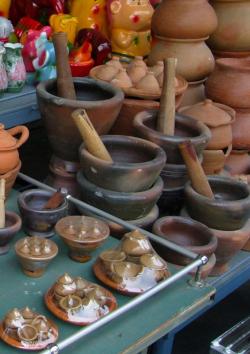Mortars are indispensable in the Thai kitchen. There are different kinds of mortars and each is unique to its locality and food and signifies eating habits of the locals.
In the past, mortars in the North and in Isan were made of either earthenware or wood. This depended on a person's skill and suitability, plus the mortar's availability.
The earthenware mortar of the North is strong as it needs to be baked twice in high temperatures. The latter is for glazing, which strengthens the mortar.

Earthenware mortars.
The earthenware mortar of Isan may not be as strong as it is fired only once under temperatures that are not too high.
Wooden mortars were more widely available. In both regions, wood is easy to find. A wooden mortar is actually more durable due to its elasticity. However, because it is lighter, you can't grind curry paste or chilli dip as fine as when you use the earthenware mortar. At the same time, you won't risk breaking it if you pound too hard like in the earthenware counterpart.
The kind of northern and Isan food that uses a mortar requires pounding, not essentially grinding, such as nam prik noom, which uses chilli, garlic and grilled shallots pounded together with salt.
Nam prik in Isan is pounded coarsely using dried chilli, garlic, shallots and pla ra jus or grilled fish and roasted rice. It's like making som tam with fresh chilli, garlic, papaya and eggplant, and pounding the ingredients together a little after seasoning.
This is how people in the North and Isan used mortars in the past. Nowadays, we see stone mortars in higher use in these two regions because of their durability. When you buy one, it should last a lifetime. It also works for different purposes from slight pounding to fine grinding. Isan people who have been using a wooden mortar their entire lives usually keep both, breaking out the wooden mortar for certain dishes like som tam.
In the Central Region, people used earthenware mortars but adapted to stone before other regions, because the central region is a hub for the stone mortar's material. The cuisine of the Central Region focuses on fine pounding in making nam prik and curry paste, and kanom jeen nam ya. For this, we need to pound fish and curry paste, blending the two well together. There is also kaeng liang that needs to be pounded with crispy fish and dried shrimp. Both require hard pounding and only the stone mortar is suitable.

Let's take a look at how the Thai stone mortar came to be. It started in Ang Sila village in Chon Buri. Around 70-80 years ago, the village made a living by carving stone mortars.
It is believed stone mortars originated from China. The mortar carvers were immigrants from China, both first and second generation. Also, the stone mortar in early years had two knobs on the side. The original version in China would make these two knobs into the shape of a lion's head. But in Thailand, it doesn't need to be so meticulous.
The knob helps to keep the mortar still during pounding. One hand can stabilise the mortar while the other keeps pounding. Without the knob, you could put your hand on the edge of the mortar and accidentally hit it. The mortar also had to be made in Ang Sila as it is the source of hard granite with a white and yellow colour, which is good for mortar-making.
In Ang Sila the land usually belongs to farmers and stones are obstacles to agriculture. So the mortar carvers in Ang Sila remove these useless stone from the people's land. The stones are usually given away for free but the carvers need to come and extract it themselves.
The extraction process requires the use of a metal stick that serves as a chisel to extract the stone out according to the size they need. Mostly, people extract it in a square shape and carve the mortar from that. Before, the mortars would tend to have a coarse surface both inside and out. The coarseness can be smoothed out by pounding rice repeatedly.

Handmade wooden mortar from the North. Photo:
Nowadays, granite stones have disappeared from Ang Sila. Chinese immigrants who carved stone for a living are no more. Still, Ang Sila remains the biggest mortar hub in Thailand. Stone mortars throughout the country are sold here. The carvers are newly trained. They use modern stone cutting equipment for extraction. Stone mortars are now perfectly smooth.
The mortar remains a necessary item for the Thai kitchen and cuisine, more purposeful than an electric blender, which is suitable only when you need to finely grind something into powder, such as dried shrimp and chilli.
In the Central Region, stone mortars aren't only for heavy pounding. They can also handle light tasks like nam prik kapi, nam prik makham, nam prik ta daeng, or grinding peanuts and crispy fish, which doesn't need to be too fine.
Some curry pastes, such as those for kaeng som, fish cake, or tod mun hua plee, also need only light pounding as we need to be able to clearly see chilli, lemongrass and kaffir lime skin. It also gives a good feeling of freshly made food.
Today, stone mortars comes in a lot of varieties to suit different preferences. But no matter what style it comes in, it still serves the same purpose. It's also possibly the only equipment that will last a hundred years, as long as you don't get tired of it.

